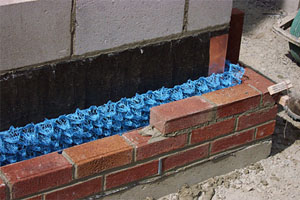December 23, 2008 9:00 AM CST

One of the oldest materials used for flashing is copper. In fact, one of the traditional stories is that the copper material used on ancient buildings to drain rain away from the roof overhang — what we call "flashing" today — got its name from the flashing of sunlight off the copper material. Whether that story is true, we don't really know. But little of today's masonry flashing ever sees the light of day; it's buried in the wall cavity.
Because it's buried, flashing has to be durable, long lasting and consistent. As Richard Lolley, president and C.E.O. of Advanced Building Products in Sanford, Maine, explains, "Flashing is one of those things that, if it fails, it's not like a door or window you take out and replace. You literally have to tear a wall down to get at it. We have seen changes with the Brick Institute of America and other trade associations looking for a better flashing, and we feel that is copper flashing. It's not the cheapest on the market, but it lasts forever."
There is a big difference between "cheap" and "inexpensive." Lolley points to a building valued at about $40 million for which they supplied the copper flashing. "We checked to see what amount of that building's cost was copper flashing. It came out to .00057% — that's the percentage of the total cost of that building to install copper flashing that's guaranteed to last the life of that building."
Copper flashing also fits into the growing green movement. Lolley says his product is made from recycled materials and qualifies for LEED points. "One of the good things about it is, again, the longevity. A big catchword now is "sustainability," and it almost goes hand-in-hand with green. With copper flashing, you make it once and put it in, and that should be it for the life of the building."
Mariano "Skip" Digiovanni in Rochester Hills, Mich., a representative of the International Masonry Institute, likes copper for flashing. "With the peel-and-stick flashing, you have to use a hard-drip edge, and a lot of architects don't like to do that. That's one thing with copper: You can bring it out to the face, and it's a done deal. It's not going to degrade.
"If you have a lot of openings that are the same size, whether they are at the header or the sill, and forming the copper in the field, up on the scaffold or wherever you're working, is a problem, you can pre-form them," he adds. "The mason can then just terminate them."
Copper Flashing
Advanced Building Products recommends flashing be done the traditional way
By Tom Inglesby

Advanced Building Products recommends flashing be done the traditional way.
Because it's buried, flashing has to be durable, long lasting and consistent. As Richard Lolley, president and C.E.O. of Advanced Building Products in Sanford, Maine, explains, "Flashing is one of those things that, if it fails, it's not like a door or window you take out and replace. You literally have to tear a wall down to get at it. We have seen changes with the Brick Institute of America and other trade associations looking for a better flashing, and we feel that is copper flashing. It's not the cheapest on the market, but it lasts forever."
There is a big difference between "cheap" and "inexpensive." Lolley points to a building valued at about $40 million for which they supplied the copper flashing. "We checked to see what amount of that building's cost was copper flashing. It came out to .00057% — that's the percentage of the total cost of that building to install copper flashing that's guaranteed to last the life of that building."
Copper flashing also fits into the growing green movement. Lolley says his product is made from recycled materials and qualifies for LEED points. "One of the good things about it is, again, the longevity. A big catchword now is "sustainability," and it almost goes hand-in-hand with green. With copper flashing, you make it once and put it in, and that should be it for the life of the building."
Mariano "Skip" Digiovanni in Rochester Hills, Mich., a representative of the International Masonry Institute, likes copper for flashing. "With the peel-and-stick flashing, you have to use a hard-drip edge, and a lot of architects don't like to do that. That's one thing with copper: You can bring it out to the face, and it's a done deal. It's not going to degrade.
"If you have a lot of openings that are the same size, whether they are at the header or the sill, and forming the copper in the field, up on the scaffold or wherever you're working, is a problem, you can pre-form them," he adds. "The mason can then just terminate them."
About the Author
Tom Inglesby is a San Diego-based freelance writer whose work has appeared in numerous online and print publications. He is the winner of the Construction Writers Association's 2002 Boger Award for Special Reports.















